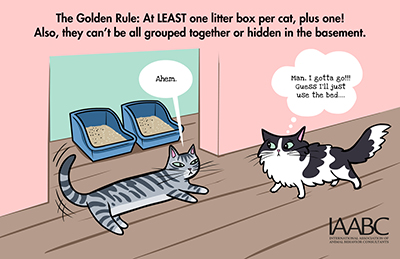One of the most seen behavior issues in cats is peeing outside the litter box. This is also the most named reason when people surrender their cat to the shelter. In almost all cases, there is an underlying reason why cats pee outside their litter box. This can be stress, a medical issue, the type of litter(box) used, or simply the way we placed the litter box inside our home. So, let’s have a look at what a perfect litter box looks like from a cat’s perspective.
The perfect litter box is:
Clean
We don’t like to sit on a dirty toilet, and the same goes for cats. Cats are by nature clean animals and have a better sense of smell than humans, so make sure that the litter box is clean. Make sure to scoop their litter at least once a day, preferably twice. Depending on the type of litter used, and the number of cats, replace all the litter every 1 to 3 weeks. Make sure to clean the litter box with soap and water and rinse it well.
Filling
Crystals, pellets, clumping litter, non-clumping litter, the choices for filling up the litter tray are endless. Most cats prefer soft, unscented, clumping litter. Scented litter may overwhelm your cat’s highly developed sense of smell. Clumping litter will make it easier to remove all the feces and urine properly and completely. It is important to make sure that all the urine is removed, which with non-clumping litter is harder. For kittens, it is advised to use non-clumping litter, as sometimes they might try and eat it. Often a cat will have a preference for a certain litter box filling, so it might take some experimentation to find something that your cat likes. Do not use liners in the litter box. Urine can get trapped under it, and some cats don’t like the sound it makes.
Location
Most people like to place the litter box out of sight and in a place or room that is barely being used. It is important though, that the litter box is easily accessible for your cat. Don’t cramp all the litter boxes in one spot but place them around the house. Make sure that the litter box is placed in a spot where the cat can relax. Away from kids, dogs, noises etc. Make sure litter boxes are not placed close to food and water bowls as cats don’t like to eliminate close to where they eat and drink.

Size/Shape
Litter boxes come in all sizes and shapes, some even automized. Some of these litter boxes might look great to us, but our cats might disagree. Make sure the litter box you get is big enough for your cat, nobody likes to be cramped up when doing their business. The length should be about 1.5 times the size of your cat. Lids and flaps to keep smells in are nice for us, but a cat might not want to go into a litter box where smell is trapped inside. Another downside of a closed litter box is that the cat might feel trapped as it takes away the opportunity to flee. Automated litter boxes are great inventions for us as humans, but for cats the sound and moving parts may be scary, which might result in them being reluctant to use the litter box.
Amount
Cats usually don’t mind playing with the same toys or using the same cat tree, but when it comes to sharing a litter box, most cats are less enthusiastic. When it comes to the right amount of litter boxes, it’s advised to have a litter box available for each cat, and as well one extra. For example, if you have two cats, you will need a minimum of three litter boxes. By making sure that everyone has their own spot available, problems regarding peeing and pooping outside the litter box might be prevented or resolved.

Conclusion
Even though each cat might have its own preference (if your current set-up works for your cat, it works, don’t change anything), generally speaking for most cats the ideal litter box would be an open box that’s filled with unscented, clumping litter. The box is placed in a quiet spot with easy access and is cleaned sufficiently. Complicated litter box set-ups are often appealing for us, but less for our cats. So, if your cat starts/is peeing outside the litter box and there is no underlying medical issue, making changes to the litter box set-up might just be the answer.
Important note: If your cat suddenly starts peeing outside the litter box, it is important to first rule out any medical issues like bladder infection or urine crystals.
The perfect litter box
Is simple and plain. A common behavior issue in cats is peeing and pooping outside of the litter box. While some cases will have medical reasons, in other cases the behavior issues are connected to the litter box setup. By this article, we hope to have informed cat owners about adjustments they can make if their cat poops and/or pees outside of their litter box. And in line with this we hope to prevent cats being re-homed while issues could be resolved. If you would like to know more about our cat sitting or cat relocation services, feel free to contact us. Our team will be happy to help.

